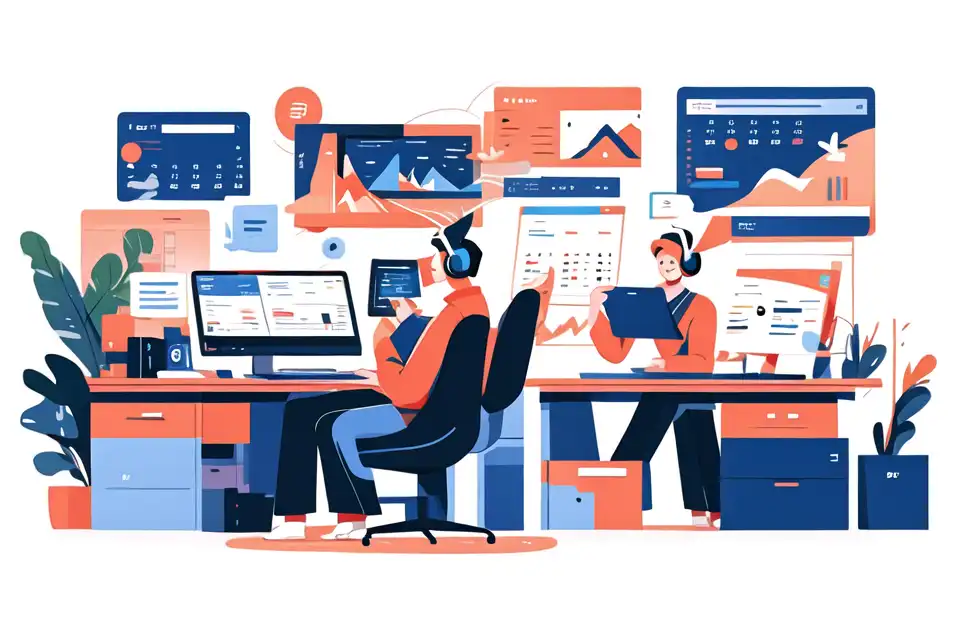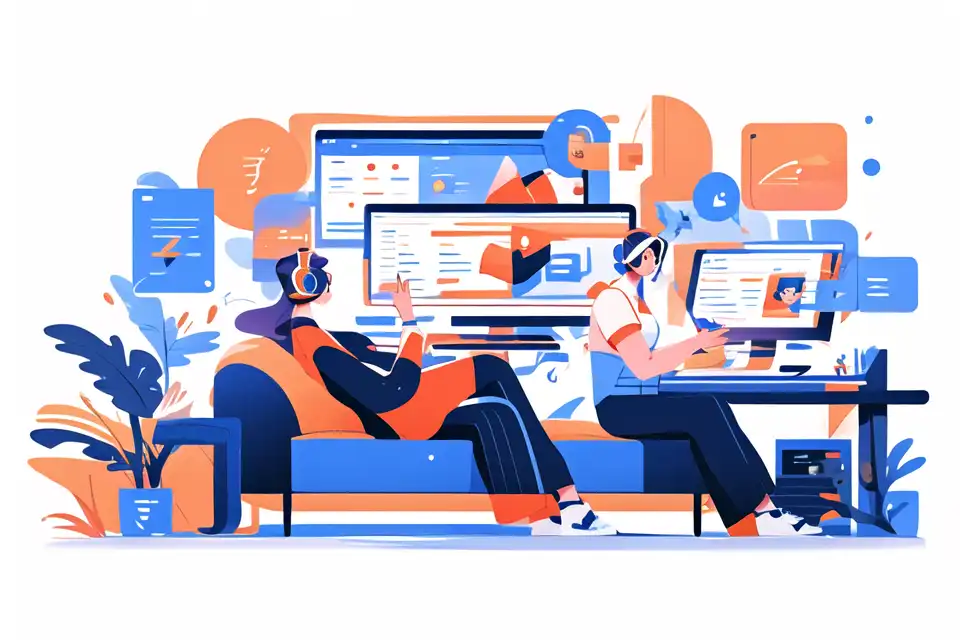Bottom-Line
Unlock the potential of Bottom-Line with our comprehensive guide. Explore essential terms and concepts to excel in the e-commerce realm with Lark's tailored solutions.
Try Lark for Free
Leverage the full capabilities of Lark Base to streamline, oversee, and successfully execute your e-commerce strategies and initiatives.
Boosting e-commerce success with bottom-line
In the rapidly evolving world of e-commerce, staying ahead of the competition requires a strategic approach. One such strategy that has gained significant importance is Bottom-Line. In this comprehensive guide, we will explore the key impacts of Bottom-Line on e-commerce in 2024 and provide a step-by-step roadmap for online retailers to implement this strategy successfully.
Understanding bottom-line in 2024's e-commerce landscape
Evolution and Definition in Online Retail Context
Bottom-Line has evolved from being a mere financial metric to a comprehensive strategy encompassing various aspects of e-commerce. In 2024, it refers to the holistic approach that online retailers adopt to optimize their operations, enhance customer experience, and drive profitability. By focusing on improving efficiency, reducing costs, and maximizing revenue, Bottom-Line has become a key driver of success in the digital commerce landscape.
Significance and Emerging Trends for Digital Commerce
In today's competitive e-commerce landscape, staying profitable while meeting customer expectations is crucial. Bottom-Line plays a pivotal role in achieving this delicate balance. By leveraging emerging trends such as automation, personalization, and omnichannel integration, online retailers can enhance their Bottom-Line and gain a competitive edge.
Dispelling Common E-commerce Misconceptions related to Bottom-Line
There are several misconceptions surrounding Bottom-Line in e-commerce. One common misconception is that it solely focuses on financial aspects. However, in 2024, Bottom-Line encompasses a broader perspective, including customer experience, operational efficiency, and long-term sustainability. By dispelling these misconceptions, online retailers can better understand the true potential of Bottom-Line in driving e-commerce success.
How Bottom-Line Fits into the Broader E-commerce Ecosystem
Bottom-Line is not a standalone strategy but an integral part of the broader e-commerce ecosystem. It aligns with other key components such as marketing, supply chain management, and customer service to create a cohesive and efficient online retail operation. By understanding the interplay between Bottom-Line and other elements, online retailers can optimize their overall e-commerce strategy.
Roi and performance metrics
2024 Projections for E-commerce ROI and KPIs related to Bottom-Line
In 2024, online retailers can expect significant returns on investment (ROI) by implementing effective Bottom-Line strategies. Key performance indicators (KPIs) such as conversion rates, average order value, and customer lifetime value are crucial metrics to monitor and optimize. By setting realistic goals and tracking these metrics, e-commerce businesses can gauge the success of their Bottom-Line initiatives.
Industry Benchmarks and Performance Standards
Benchmarking against industry standards and performance metrics is essential for online retailers to assess their Bottom-Line performance objectively. By comparing their KPIs with industry leaders and competitors, businesses can identify areas for improvement and implement strategies to outperform the competition.
Case Studies: Online Sales Boosts Achieved through Effective Bottom-Line Implementation
Real-world examples of successful Bottom-Line implementation can provide valuable insights for online retailers. Case studies showcasing how e-commerce businesses have achieved significant sales boosts by optimizing their operations, enhancing customer experience, and improving profitability through Bottom-Line strategies can serve as inspiration and guide retailers in their own implementation efforts.
Measuring the Impact of Bottom-Line on Customer Lifetime Value and Retention
Customer lifetime value and retention are critical factors in e-commerce success. By implementing effective Bottom-Line strategies, online retailers can enhance customer satisfaction and loyalty, leading to increased customer lifetime value and improved retention rates. It is essential for businesses to measure and analyze the impact of Bottom-Line on these key metrics to drive long-term profitability.
Learn more about Lark x E-Commerce
Implementing bottom-line in your online store
2024 Best Practices for E-commerce Platforms
E-commerce platforms play a vital role in implementing Bottom-Line strategies effectively. In 2024, online retailers should focus on selecting platforms that offer robust analytics and reporting capabilities, seamless integration with other business systems, and flexibility for customization. By choosing the right platform and utilizing its features optimally, businesses can lay a solid foundation for successful Bottom-Line implementation.
Step-by-Step Guide to Integrating Bottom-Line into Existing Operations
Implementing Bottom-Line requires a systematic approach. This step-by-step guide provides online retailers with a roadmap to integrate Bottom-Line into their existing operations. From setting goals and defining key metrics to identifying areas for improvement and implementing necessary changes, this guide helps businesses navigate the implementation process smoothly.
Tools and Technologies Streamlining Bottom-Line for Digital Retail
In the digital era, various tools and technologies can streamline the implementation of Bottom-Line strategies. From automated inventory management systems to AI-powered customer service chatbots, online retailers have access to a wide range of solutions. This section explores the tools and technologies that can enhance efficiency, reduce costs, and maximize revenue in the context of Bottom-Line.
Overcoming Unique Online Retail Challenges in Bottom-Line Adoption
Implementing Bottom-Line in the online retail landscape comes with its own set of challenges. This section highlights the common challenges faced by e-commerce businesses and provides strategies to overcome them. From managing inventory and logistics to optimizing pricing strategies and mitigating cybersecurity risks, businesses can proactively address these challenges to ensure successful Bottom-Line adoption.
Resource Allocation and Budget Considerations
Implementing Bottom-Line strategies requires proper resource allocation and budget planning. This section provides insights into effectively allocating resources and budget for Bottom-Line initiatives. By prioritizing investments based on potential impact and aligning budget allocation with strategic goals, online retailers can optimize their resource utilization and maximize the return on investment.
Industry insights and e-commerce benchmarks
2024 Expert Panel Insights on Bottom-Line in Digital Retail
Industry experts provide valuable insights into the future of Bottom-Line in e-commerce. This section features perspectives from renowned professionals who share their thoughts on the evolving role of Bottom-Line, emerging trends, and best practices for success. Online retailers can gain valuable knowledge and inspiration from these expert insights.
Success Stories from Leading Online Stores across Various Sectors
Real-life success stories from leading online stores across different sectors demonstrate the power of Bottom-Line in driving e-commerce success. By analyzing these success stories, businesses can learn from the strategies implemented by industry leaders and adapt them to their own operations. These examples showcase the versatility of Bottom-Line and its applicability across various e-commerce niches.
Comparative Analysis of Bottom-Line Implementation in Different E-commerce Niches
Different e-commerce niches have unique characteristics and challenges. This section provides a comparative analysis of Bottom-Line implementation in various niches, highlighting the similarities and differences. By understanding how Bottom-Line strategies can be tailored to specific niches, online retailers can develop targeted approaches that align with their industry dynamics and customer expectations.
Lessons Learned and Pitfalls to Avoid
Learning from the mistakes and experiences of others can save e-commerce businesses valuable time and resources. This section outlines common pitfalls to avoid when implementing Bottom-Line strategies and shares lessons learned from previous implementations. By being aware of these pitfalls, online retailers can navigate the implementation process more effectively and increase their chances of success.
Learn more about Lark x E-Commerce
Omnichannel integration strategies
Seamlessly Connecting Online and Offline Bottom-Line Processes
Omnichannel integration is essential for e-commerce businesses to provide a seamless customer experience. This section explores strategies to connect online and offline Bottom-Line processes, enabling retailers to offer consistent pricing, promotions, and customer service across all channels. By embracing omnichannel integration, businesses can enhance their Bottom-Line and deliver a unified commerce experience.
Creating Unified Commerce Experiences across Multiple Touchpoints
Customers interact with online retailers through various touchpoints, including websites, mobile apps, social media, and physical stores. This section delves into the importance of creating unified commerce experiences across these touchpoints and how Bottom-Line can be leveraged to achieve this goal. By providing a consistent brand experience, online retailers can increase customer satisfaction and drive revenue growth.
Leveraging Bottom-Line to Enhance Customer Experience in Omnichannel Retail
Customer experience is a key differentiator in the highly competitive e-commerce landscape. This section explores how Bottom-Line can be leveraged to enhance the customer experience in omnichannel retail. From personalized recommendations to seamless order fulfillment, online retailers can utilize Bottom-Line strategies to delight customers at every touchpoint and drive brand loyalty.
Case Studies of Successful Omnichannel Integration Involving Bottom-Line
Real-world case studies showcase successful implementations of Bottom-Line strategies in omnichannel retail. This section presents examples of online retailers that have effectively integrated their online and offline operations to deliver exceptional customer experiences and maximize their Bottom-Line. By studying these case studies, businesses can gain insights into the practical application of Bottom-Line in an omnichannel context.
Customer experience and personalization
Utilizing Bottom-Line to Enhance Customer Satisfaction and Loyalty
Customer satisfaction and loyalty are crucial for long-term success in e-commerce. This section explores how Bottom-Line can be leveraged to enhance customer satisfaction and loyalty. By optimizing processes to deliver faster shipping, offering hassle-free returns, and providing exceptional customer service, online retailers can create a positive customer experience that drives repeat business and brand advocacy.
Personalization Strategies Powered by Bottom-Line
Personalization is a key trend in e-commerce, and Bottom-Line can play a vital role in implementing effective personalization strategies. This section dives into how online retailers can leverage Bottom-Line to collect and analyze customer data, segment their audience, and deliver personalized experiences at scale. By tailoring product recommendations, promotions, and communications, businesses can create meaningful connections with their customers.
Balancing Automation and Human Touch in Customer Interactions
Automation has revolutionized e-commerce operations, but human touch remains important in customer interactions. This section explores how online retailers can strike the right balance between automation and human touch to deliver exceptional customer experiences. By combining efficient automated processes with personalized human interactions, businesses can create a winning formula that enhances their Bottom-Line.
Measuring and Optimizing Customer Experience in the Context of Bottom-Line
Measuring and optimizing customer experience is crucial for e-commerce success. This section provides insights into the key metrics and tools online retailers can utilize to measure customer experience. By analyzing customer feedback, monitoring key performance indicators, and leveraging data analytics, businesses can continuously improve their customer experience and drive their Bottom-Line.
Learn more about Lark x E-Commerce
Future of online retail: 2024 and beyond
Emerging E-commerce Technologies and Trends Related to Bottom-Line
The future of online retail holds exciting possibilities, driven by emerging technologies and trends. This section explores how technologies such as artificial intelligence, augmented reality, and blockchain can impact Bottom-Line strategies. By staying informed about these advancements, online retailers can prepare for the future and leverage innovative technologies to enhance their Bottom-Line.
Predictive Analysis of Bottom-Line Evolution in E-commerce
Predicting the future evolution of Bottom-Line in e-commerce is essential for businesses to stay ahead of the curve. This section provides insights into the potential trajectory of Bottom-Line strategies, based on market trends and industry projections. By understanding the potential challenges and opportunities that lie ahead, online retailers can develop proactive strategies to ensure their long-term success.
Preparing for Future Challenges and Opportunities
The e-commerce landscape is constantly evolving, presenting both challenges and opportunities. This section highlights the key challenges that online retailers may face in the future, such as increasing competition and changing consumer expectations. It also explores the opportunities that arise from emerging trends and technologies. By anticipating these challenges and opportunities, businesses can position themselves for sustained success.
Long-Term Strategies for Staying Competitive with Bottom-Line
Staying competitive in the ever-changing e-commerce market requires long-term strategies. This section provides insights into the strategies that online retailers can adopt to maintain their competitive edge with Bottom-Line. From continuous innovation and adaptation to fostering a customer-centric culture, businesses can build a sustainable advantage and thrive in the dynamic e-commerce landscape.
2024 action plan for e-commerce success
Comprehensive Steps to Optimize Bottom-Line for Your Online Store This Year
Taking action is crucial for implementing Bottom-Line strategies successfully. This section outlines a comprehensive action plan for online retailers to optimize their Bottom-Line in 2024. From conducting a thorough assessment of current operations to implementing targeted improvements and monitoring progress, businesses can follow this step-by-step plan to drive e-commerce success.
Prioritization Framework for Bottom-Line Initiatives
With limited resources and time, prioritizing Bottom-Line initiatives is essential. This section provides a framework for prioritizing initiatives based on their potential impact and alignment with strategic goals. By evaluating the feasibility, cost, and expected return of each initiative, online retailers can focus their efforts on the most impactful projects and maximize their Bottom-Line.
Change Management Strategies for Smooth Implementation
Implementing Bottom-Line strategies often involves significant changes to existing processes and workflows. This section explores effective change management strategies to ensure a smooth implementation. From communicating the rationale for change to providing training and support, businesses can minimize resistance and facilitate a successful transition to the new Bottom-Line approach.
Key Performance Indicators (KPIs) to Track Progress and Success
Tracking progress and success is crucial for ongoing improvement and performance evaluation. This section identifies key performance indicators (KPIs) that online retailers should track to measure the effectiveness of their Bottom-Line initiatives. By regularly monitoring these KPIs and adjusting strategies accordingly, businesses can optimize their Bottom-Line and drive continuous improvement.
Learn more about Lark x E-Commerce
Conclusion
In conclusion, Bottom-Line is a strategic approach that online retailers must embrace to thrive in the ever-evolving e-commerce landscape. By understanding the key impacts of Bottom-Line in 2024, implementing best practices, and leveraging emerging trends and technologies, businesses can optimize their operations, enhance customer experience, and drive profitability. With a comprehensive action plan and a long-term perspective, online retailers can position themselves for sustained success in the dynamic world of e-commerce.
Leverage the full capabilities of Lark Base to streamline, oversee, and successfully execute your e-commerce strategies and initiatives.








